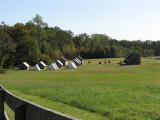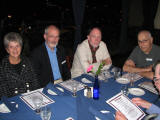![]()
Appalachian Autumn (2008) Tour
Part 11: Pamplin Historic Park, Alexandria
This is the end of our travel blog until we return home. We're leaving tomorrow morning for Centralia via Washington, Chicago, and Portland. With some luck, our pre-arranged transport van will meet us at the Centralia Amtrak station on Monday afternoon.
Today (Thursday), we made a very short hop from our hotel in Petersburg, VA to the Pamplin Historic Park, which offers several Civil War museums and living history exhibits. Petersburg is the spot where the Federal (Union) troops made the final and fatal breach of the Lee's Confederate line on April 2, 1965. Just seven days later, Lee would surrender to Grant at Appomattox.
The museum is a combination of high-tech multimedia, conventional museum exhibits, and living history presentations. I elected to walk the approximately two mile trail that winds through the area where the Federal breakthrough occurred. You can still clearly see the dirt embankments created by the Confederate troops, and in a few places it's quite possible to discern smaller depressions used to hide rifle positions. One of the more interesting multimedia exhibits was a collection of three-dimensional (stereo) photographs taken around the area in 1865, displayed on a large screen where 3D glasses could be used to view. This was the first war of which we have a detailed photographic record. Several pictures showing piles of dead and injured troops littered across the landscape were especially moving.
The brutality of the Civil War conflicts is hard to fully comprehend. The Park contained numerous exhibits related to the extreme injuries sustained by both sides. Amputation was extremely common, as it was the only surgical solution to the shattered limbs that resulted from the large bullets (about 5/8" in diameter) that were used.
We watched a live demonstration of rifle loading and firing. At the fastest, a Civil War-era rifle could be fired every twenty seconds - for a brief period of time before the rifle needed to be cleaned, or the soldier needed to move or rest. Of course during those twenty seconds, the soldier preparing to fire was incredibly exposed to shots coming in from opposing troops.
At the "breakthrough" where the Federal troops crossed the Confederate line, there were approximately 14,000 Federals and 2,800 Confederates. Having been cut off from food for several days, the much smaller Confederate lines simply could not fend off the Federal attack. The troops that were ordered to attack considered it a death sentence. Many of them wrote their names and home towns on their uniforms in hope that someone would tell their relatives if they were killed during the battle. I'm still researching the injury and casualty count for this single battle.





















